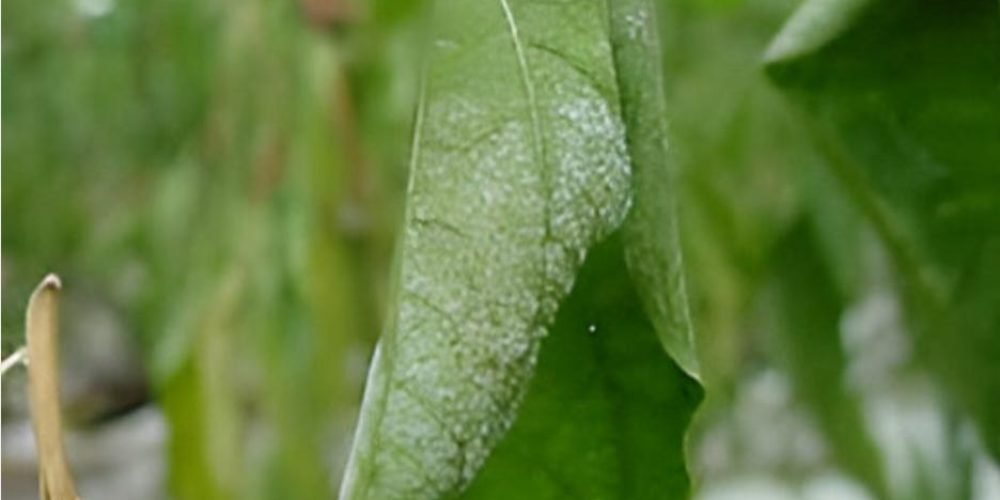Soft wilt disease or seedling drop disease in pepper
- Fungal disease
- Etiology:
- Cause: It is caused by many fungi, the most important of which are:
- The infection causes the seeds to rot before they appear on the surface of the soil, and this is known as soft wilt.
- Germination: This often happens in trays that are planted for the purpose of producing seedlings when any malfunction occurs in the preparation
- Trays for cultivation (lack of good sterilization, heavy irrigation, etc.), and death of seedlings also occurs when
- Our agriculture is in sustainable land
Among the fungi that cause soft wilt in pepper are the following:
Fusarium solani
Alternaria spp
Rhizoctonia solani
Pythium spp.
Phytophthora spp
- Symptoms:
The infection may lead to the seeds rotting before they appear above the soil surface. This is known as pre-emergence damping-off, and it appears in the form of a decrease in the germination rate. The infection may appear in the form of atrophy in the lower embryonic stalk of the seedling at the soil surface level. As a result, the seedling wilts, and its upper green part falls to the surface of the soil. This is known as seedling drop. Post-emergence damping-off
This... Seedlings become resistant to soft wilt when their stems harden slightly, which occurs approximately 15-20 days after germination.
- Suitable conditions for injury:
Relatively high temperatures (or low temperatures in the case of infection with the fungus Pythium spp), high ground humidity, lack of lighting and ventilation, and increased plant density are suitable for soft wilt. All of these conditions make the seedlings delicate, weak, and resistant to the fungi that cause the disease.
- Control:
Soft wilt is combated by taking into account the following:
- Sterilizing nurseries before planting them.
- Avoid dense planting of nurseries.
- Nurseries are well ventilated.
- Moderation in watering nurseries.
- Treating seeds and nurseries with pesticides.
Seeds are treated before planting with one of the fungal disinfectants, such as: Vitafax/Captan, Vitafax/Theram, Simsan, or Orthoside at a rate of 1.5 grams of the pesticide per kilogram of seed. If the infection appears, it is recommended to moisten the nursery with a diluted solution of Captan, Copran, or Benelite at a concentration of 0.25%, at a rate of about a liter of solution per square meter of the nursery, with the treatment repeated every 7 days if the infection continues.
- Biological control:
Peppers could be well protected from soft wilt caused by the fungus Rhizoctonia solani by treatment with both the fungi Gliocladium virens (isolates 3-Gl and 21-Gl) and Trichoderma hamatum (isolate Lewis) (TRI-4 et al. 1995).
It is also possible to control both R. solani and Pythiumn ultimum by treatment with the fungus Cladorrhinum foecundissimum (Lewis & Larkin 1998).
It was also beneficial to treat pepper seeds, seedling production mixtures, or seedlings with a mixture of both the fungus Gliocladium virens (strain 3-Gl) and the bacteria Burkholderia cepacia (strain Bc-F) together. This was beneficial in protecting the seedlings from infection with both wilt fungi. Soft wilt: R. solani, P. ultimun, Fusarium oxysporium, Sclerotium rolfsii = Corticium folfsii, but treatment with neither of them alone was effective in controlling soft wilt (Mao et al. 1998).
It was also possible to combat root rots caused by the fungi: R. solani, Fusarium solani, and C. rolfstt by treatment with both the mycorrhizal fungi Trichoderma sharzanum and T. wiride (Ellil et al. 1998).
- Pythium fungi
- One of the aquatic oomycetes is a parasite that lives in the soil and feeds on organic matter. Some types of Pythium can cause serious diseases on plant crops under protected greenhouses, leading to major crop losses. Fungal infection leads to wilting, the fall of seedlings and seedlings, and rotting of the roots of mature plants. There are several Pythium species, including P. aphanidermatum, P. irregulare and P. Ultimum, causes wilting, dropping of seedlings and root rot in greenhouse crops of cucumbers, peppers and tomatoes. There are no Pythium resistant varieties, but there are some varieties that may tolerate the disease. Overwatering, poor root aeration, root injuries and unsuitable temperatures in the root zone can all weaken the crop and thus lead to an outbreak of Pythium fungus.
Plants grown under optimal environmental conditions are less susceptible to Pythium than plants grown in poor conditions.
Damage
Pythium infects seeds, young tissues, ground stems, and roots, and the extent of damage depends on the affected area.
Seedlings fall
Plants are most susceptible to infection by Pythium during the stages of germination and seedling formation. The initial symptoms are weak and uneven germination (seedlings wilting before they appear). Seedlings are exposed to wilting, and the plants can be completely destroyed at this stage.
Leg rot
Stem infection occurs in areas near the soil surface, especially at the beginning of germination. The infestation appears in the form of watery, slimy spots near the surface of the soil. The spots may extend and form a large blight, making the stem weak and susceptible to breakage. If a fungicide is used, the disease stops, the plant begins to recover, and the infected spot turns brown
Root rot
Pythium root rot causes wilting, loss of vitality, stunting, chlorosis, chlorosis and leaf fall, as the fungus prevents root growth and blackens the roots, making them soft and rotten. Symptoms begin at the root tip. The rotten portion of the roots may extend to expose the internal primary roots. Underground storage roots are also at risk of infection by P. aphanidermatum. Even mature tissue can be injured and destroyed. Beets and other tuberous roots are susceptible to rotting in the field and during storage.
Lifecycle
Pythium infection can be transmitted to greenhouses during seedling operations or with soil, various crops, and irrigation water. . Greenhouse insects and pests such as fungus gnats (impatiens Bradysia) and flies (Scatella stagnant) can also carry Pythium and transport it into the greenhouse. . Pythium spreads by forming bacterial cysts, each of which produces hundreds of swimming spores. The swimming spores reach the surface of the roots, germinate and form colonies of fungal hyphae called mycelium. These hyphae release enzymes to destroy root tissue and absorb nutrients as a food source.
. The fungus Pythium forms oocysts, chlamydospores and chlamydospores on decaying plant roots that can survive prolonged unfavorable conditions in soil, greenhouses and water and subsequently re-infect



